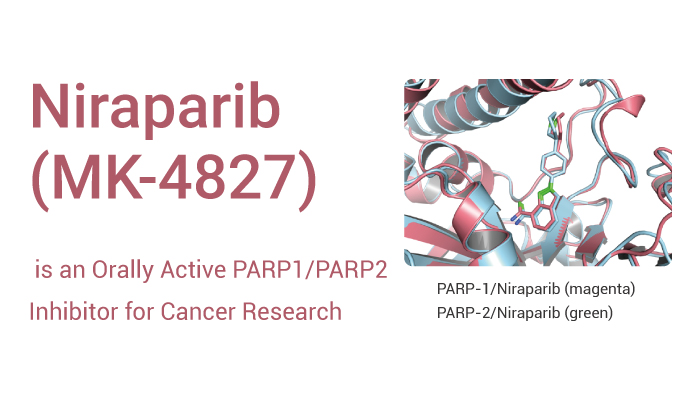Poly (ADP-ribose) polymerases (PARPs) are a family of related enzymes that share the ability to catalyze the transfer of ADP-ribose to target proteins. There are at least 18 members of the PARP family. Some isoforms including PARP1 and PARP2 are best known for their involvement in DNA repair processes. Meanwhile, these and other PARPs have an important role in several cellular processes including cell proliferation and cell death. Cancer cells deficient in BRCA1 and BRCA2 are selectively hypersensitive to PARP inhibitors. PARP inhibitors may also increase tumor sensitivity to DNA-damaging agents. Meanwhile, the hyperactivation of PARP also results in a specific programmed cell death pathway.
PARP1 is an abundant nuclear protein and the founding member of the PARP family. It binds damaged DNA through its N-terminal zinc finger motifs. PARP2 is most closely related to PARP1 with 69% similarity in its catalytic domain. PARP2, although less abundant and contributing 5% to 10% of the total PARP activity, is essential for the viability of PARP1 knockout mice. AutoPARylation of PARP1 and PARP2, and PARylation of chromatin proteins promote the recruitment of DNA repair factors. Because of the high negative charge of PAR polymers, extensive autoPARylation of PARP1 and PARP2 leads to their dissociation from DNA, which is required for DNA repair completion.
Niraparib (MK-4827) is a highly potent and orally active inhibitor of PARP1 and PARP2.

Niraparib displays excellent PARP 1 and 2 inhibition in a whole-cell assay. Therefore, Niraparib leads to inhibition of repair of DNA damage, activates apoptosis and shows anti-tumor activity. Specifically, MK-4827 inhibits the proliferation of cancer cells with mutant BRCA-1 and BRCA-2. What’s more, Niraparib exhibits good tolerance and demonstrates efficacy as a single agent in a xenograft model of BRCA-1 deficient cancer. Niraparib shows efficacy in the research of epithelial ovarian, fallopian tube, or primary peritoneal cancer.
All in all, Niraparib is a potent and orally active inhibitor of PARP1 and PARP2. Niraparib exhibits anti-tumor activity in epithelial ovarian, fallopian tube, or primary peritoneal cancer.
References:
[1] Morales J, et, al. Crit Rev Eukaryot Gene Expr. 2014;24(1):15-28.
[2] Lee A, et, al. Target Oncol. 2021 Nov;16(6):839-845.